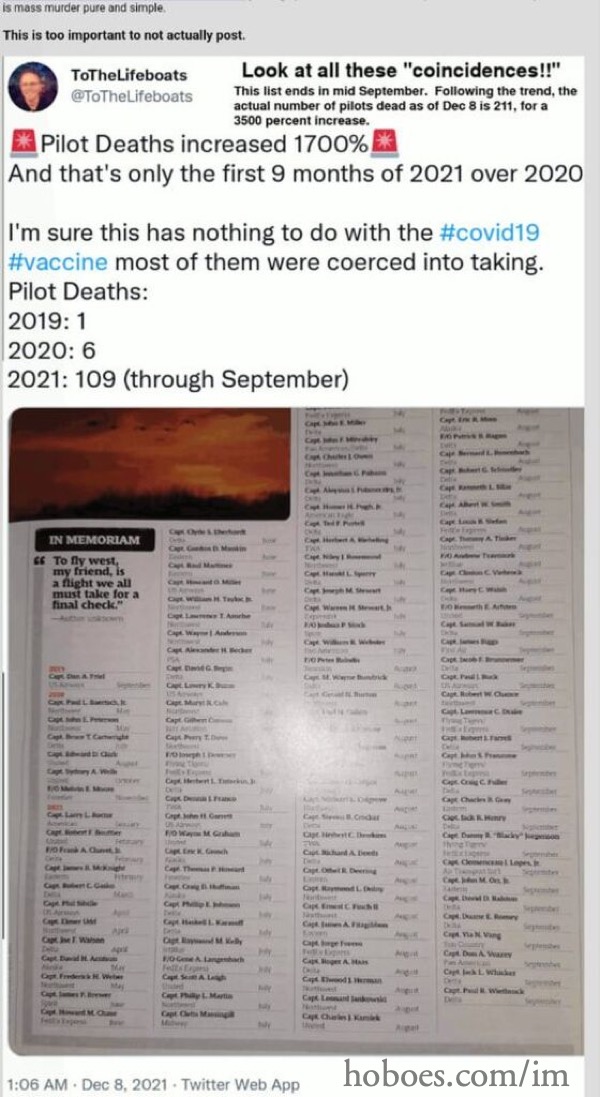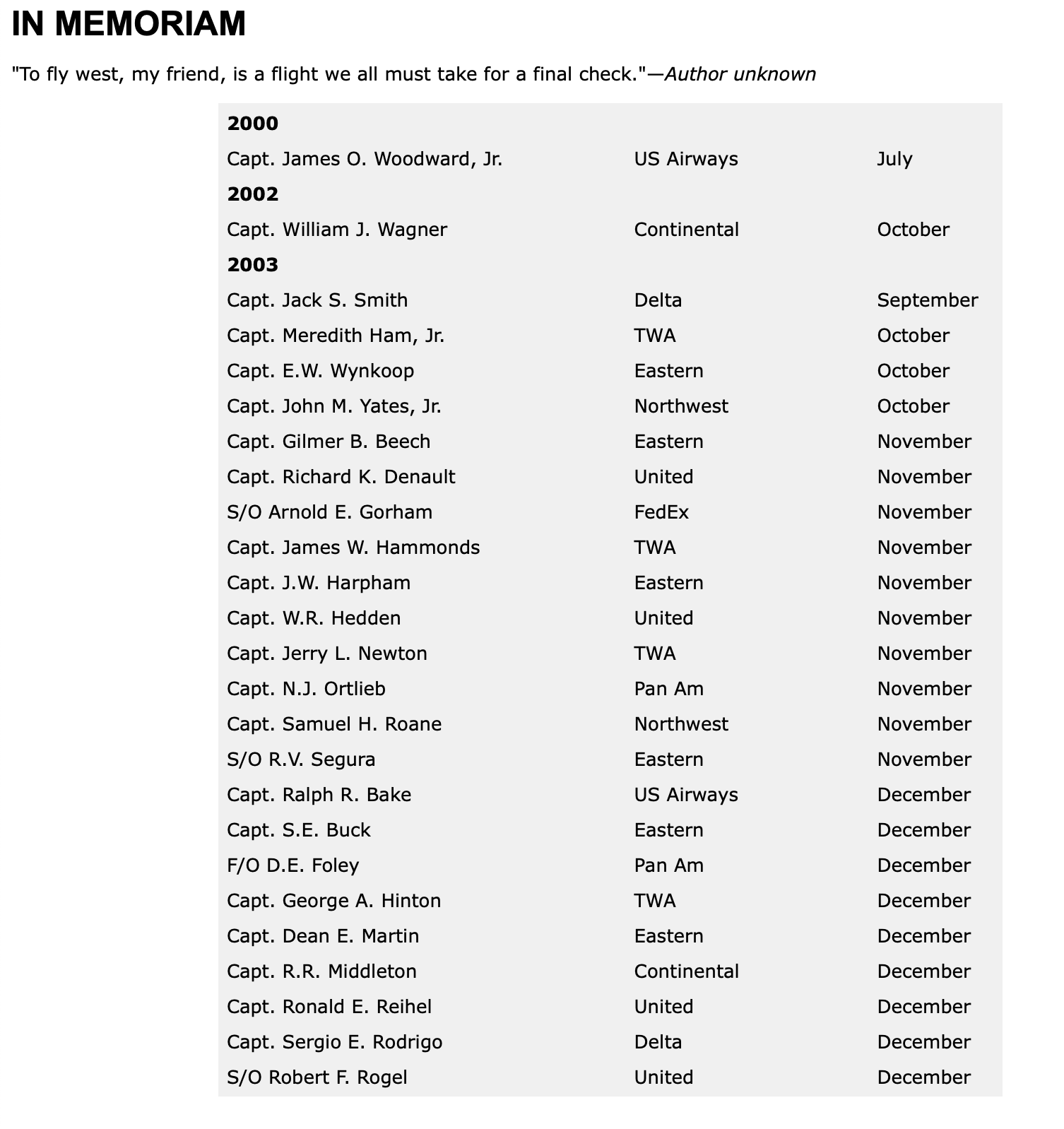In memoriam: vaccinations killing pilots

It’s difficult to know what’s real and what’s not real nowadays. No one on any side of any aisle trusts the media to report news correctly, and with good reason. But it remains necessary to have some means of accurately gauging assertions from outside the news media.1
Sometimes, it’s easy to do. But the media’s constant death of x, film at 11 exaggerations have atrophied our ability to see complete hyperbole for the nonsense it is.
“Pilot deaths increased 1700%, and that’s only the first nine months of 2021 over 2020!”
I’m not sure the original memer wasn’t just making this up to see who would spread it around. All the information needed to recognize it as nonsense is in the meme. It quotes a 1700% increase and then says, “that’s just the first nine months!” In other words, according to this meme, pilot deaths likely increased by 2300 percent over 2020.
Think about that for a moment. What would the consequences be of pilots dying at more than 20 times the rate they did last year, and more than 140 times the rate they did in 2019? That’s a lot of deaths, and a lot of planes that can’t be flown. It’s a lot of people who can’t get where they’re going and a lot of packages that can’t be delivered.
You can choose to believe that the major media outlets would try to hush that up. Given how they’re trying to cover up inflation as (a) nonexistent and (b) a good thing, I can’t argue it. But the pilots who have to take over from the dead wouldn’t be able to keep silent. The unions losing members and the airlines losing employees wouldn’t be able to keep silent. You’d almost literally expect planes to be falling out of the sky.
This would be impossible to cover up. This is an industry that’s already suffering a well-publicized shortage of employees. The inflation and supply chain issues we’re seeing today is nothing compared to what we’d be seeing if those numbers represented what the meme says they represent.
The conclusion is that these either do not represent all deaths, or not all of them are pilots. And the answer is, both. This is a magazine for pilots, specifically members of the Air Line Pilots Association.2 Every month they publish an In Memoriam list of members who they’ve recently been informed have died; they provide the list by year. If they’ve received reports of deaths they’ve missed from the previous years, they include those. Which is why the deaths for previous years are so low: most of those years’ deaths have already been listed.
The list isn’t all of the deaths from 2021. It’s all the deaths they’ve been informed of since the last issue went to press. It’s not all of the deaths from 2020 or 2019. It’s all the deaths from those years that they’ve been informed of since the last issue went to press. That’s why the 2020 and 2019 lists are so small: most of those deaths were printed in earlier issues. You can see the same pattern in the organization’s archives, such as the February 2004 issue. The issue likely went to press in or around December of 2003, and so there is a huge listing for 2003 and a small listing for 2002 and 2000.

What strange killer ran through the airline pilot community in 2003?
I found that list by searching for the quote that heads off the In Memoriam list.
“To fly west, my friend, is a flight we all must take for a final check.”
Further, these aren’t all working pilots. It includes retired members. The people pushing the meme expect a higher death rate among those who fly, not among those who used to fly. But many of the ALPA members listed In Memoriam were no longer flying. That means the list can’t address the altitude=death theory.3
Now, the person who posted this to our chat group is someone who almost certainly would have shown the appropriate skepticism if, for example, this meme presented data showing that shifts in climate mean the world will end in five years. They’d recognize that this is the same claim that’s been made for far longer than five years.
And those of you who believe that a third or more of all COVID cases result in hospitalization shouldn’t be laughing at him. This would have obvious consequences that aren’t visible anywhere in your daily lives. If the rate was even 1% the effects on the economy and the supply chain alone would have been far worse than it was. At more than 30%, 40%, 50%, we’d all be moving to Colorado or Vegas.4 Yet people believe it.5
It is very important to maintain skepticism about extraordinary claims that fit what we believe. Those are the claims that most easily get past our skepticism, so we need extra care to maintain our skepticism in the face of it.
The first principle is that you must not fool yourself—and you are the easiest person to fool. — Richard Feynman (Surely You’re Joking, Mr. Feynman!•)
Always ask, “what does this mean, beyond that it proves me right and them wrong?” What are the consequences if this is true? Where will its effects be seen? The more extraordinary the claim, the more consequences the claim’s truth will have, and the more effects it will have outside the bare statement. Do you see them?
These are the easiest questions to ask about any such claim. There are more difficult questions, such as what are alternate explanations for this data? Or is this even data at all? But often just asking the easy questions will allow you to safely categorize the claim as likely, unlikely, or extremely unlikely.
In response to The scientific creed: If science is your religion, you have chosen the hardest religion of all. If science is your religion, you don’t prove yourself right. You prove yourself wrong.
And, increasingly, from inside the news media. The news is becoming more and more indistinguishable from hysterical memers. That guy on ABC seems especially to have mastered the art of sounding like he’s reporting a great crisis no matter what the actual story is.
↑The Air Line Pilots Association represents “more than 61,000 pilots”. That’s less than a tenth of the total pilots in the United States and Canada.
↑The theory is that the vaccines make flying more dangerous due to an exacerbation of the effects of pressure changes in airplane cabins. That’s why, in my search for consequences, I didn’t bother with, why isn’t everyone dying in such droves? If the theory is correct, we wouldn’t expect that anyway.
↑I’d like to think I’d be choosing Colorado.
↑If you’ve caught the irony (or hypocrisy) of believing this poll report after just complaining about how unreliable the news is, the fact is I don’t know that I believe this either. It’s very difficult to believe that anyone could think that COVID is putting a third to a half of everyone it touches pre-Trump vaccine into the hospital. Unless they also paradoxically think that the virus was so hard to spread that practically no one caught it.
But then I ask the same question: if people really did believe this in those numbers, what would the consequences be? And I look around, and I see the panic and the hysteria and the divisive hatred that would result if half the United States believed this was a civilization-ending disease. It’s still hard to believe, but it’s not so outrageous as it ought to be.
↑
- Air Line Pilots Association
- “Advancing aviation safety and security since 1931.”
- ALPA In Memoriam February 2004 at Air Line Pilots Association
- Air Line Pilots Association In Memoriam for February 2004.
- The End of the Internet, Film at 11… Again
- Again? Is it really the end of the Internet as we know if if Net Neutrality isn’t passed NOW NOW NOW NOW NOW1!!!???
- U.S. Adults’ Estimates of COVID-19 Hospitalization Risk: Jonathan Rothwell, Ph.D. at Gallup
- “For both vaccinated and unvaccinated populations, very few adults reported a correct answer, which is less than one percent… For unvaccinated hospitalization risk, 2% of Democrats responded correctly, compared with 16% of Republicans. In fact, 41% of Democrats replied that at least 50% of unvaccinated people have been hospitalized due to COVID-19.”
More vaccines
- A disappointing COVID Summer of Death
- When the COVID summer of death failed to materialize, it challenged the religious faith of mask and vaccine fanatics.
- How to overcome vaccine hesitancy
- We need to take a lesson from Mark Twain. The best way to reinforce vaccine hesitancy is to force vaccinations. The best way to overcome vaccine hesitancy is to act as if vaccination is desirable.
